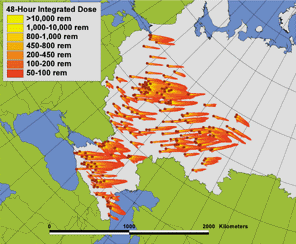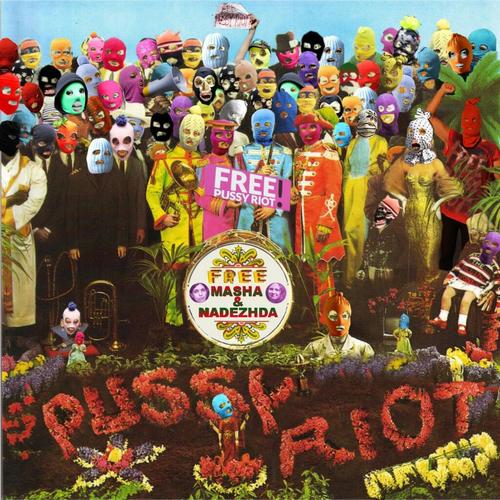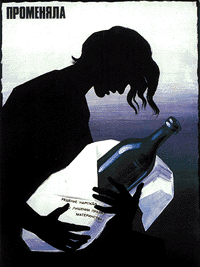russia
 Video of Steven Heller narrating a few themes from his new book Iron Fists: Branding the 20th-Century Totalitarian State, showing images of symbols, youth and of the “great leader” in fascist Germany and Italy and communist Russia and China.
Video of Steven Heller narrating a few themes from his new book Iron Fists: Branding the 20th-Century Totalitarian State, showing images of symbols, youth and of the “great leader” in fascist Germany and Italy and communist Russia and China.
Mapping the Apocalypse
From the Bulletin of Atomic Scientists, July/August 2001:
“You might think that a senior U.S. senator — let’s say the ranking member of the Senate Intelligence Committee — would be able to get straight answers about the [Single Integrated Operational Plan, or SIOP]. But that wasn’t the case when Sen. Bob Kerrey of Nebraska asked for details about the targeting plan. Congress and the president are tasked by the Constitution with a vital role in determining national security policy, ‘but how can we provide the policy guidance that is needed,’ the former senator asked last October in a letter to then-Defense Secretary William Cohen, ‘if we are not given the information we need to decide if our current course of action is the correct one?’
Specifically, Kerrey wanted a peek at the SIOP, which directs how U.S. nuclear forces will be used in any number of crises. One might assume it includes targets, population figures, force numbers, weapon specs, and so forth. But that would be a guess, since nobody outside a small military circle has seen it.
What started Kerrey and other members of the Senate Democratic Caucus on their quest for information was the Joint Chiefs’ claim that the United States could not realistically reduce its number of nuclear warheads below 2,500. They asked: Why that magical number and not some other number? But their questions went unanswered....
‘Anyone who has been doing research in this area has to look at the war plan, the SIOP,’ said [Natural Resources Defense Council] Senior Staff Analyst Robert S. Norris. At an early point in the project, it dawned on him that the difficulty experts have with discussing lower numbers of nuclear weapons was directly related to the war plan itself. If you have a certain number of targets, the plan has to have a corresponding number of warheads to deal with them.... As the project progressed, Norris said they began to hope that they could use the model to show how a smaller number of nuclear weapons — a much smaller number — could be as effective a deterrent as the more than 10,000 we have today.
But rather than pulling some magic number out of a hat, NRDC ran a series of specific scenarios with their program — three of which are published in their report, ‘The U.S. Nuclear War Plan: A Time for Change’ — which allowed them to generate the pictures and maps that illustrate the outcomes visually.
‘We couldn’t have done this 10 years ago,’ Norris said. ‘Advances in satellite imagery and computers, greater information about Russia in general, and increased access to information have made it possible. We hope people can use this program to reflect more deeply about the SIOP problem, and we want to show how the SIOP prevented progress [in arms reductions] during the Clinton administration. Our goal is to change the circumstances that will allow us to live in a safer world.’...
In the earliest days of the Cold War, the United States mainly targeted large cities. But as the number of missiles grew, it eventually had enough warheads to target individual Soviet weapons and bases, and military targeteers took the position that a strategy targeting weapons and not people — counterforce — was more ‘moral.’
 Just one problem. If you lob enough nukes to take out the Kozelsk missile fields more than 200 kilometers west of Moscow (to use one of the examples detailed in the NRDC report), you’re incidentally going to kill millions of people. So while counterforce doesn’t target people, per se, millions of civilians are still at risk.
Just one problem. If you lob enough nukes to take out the Kozelsk missile fields more than 200 kilometers west of Moscow (to use one of the examples detailed in the NRDC report), you’re incidentally going to kill millions of people. So while counterforce doesn’t target people, per se, millions of civilians are still at risk.
‘After we did our analysis,’ Cochran said, ‘it raised some interesting issues about countervalue versus counterforce. For example, if you can hold at risk one-third of Russia’s population with a single submarine, you can go to very deep reductions without feeling naked in the absence of your deterrent capability.’
So when talking about the morality of any nuclear targeting strategy one thing quickly becomes clear: It’s all horrific. NRDC takes the extra step of presenting these scenarios graphically so the public, and not just experts, can understand the results....
According to Bruce Blair, while there are many models of strategic nuclear exchanges, they don’t take the step that the NRDC model has taken to provide graphic representations of targets and the consequences of an attack that you can appreciate visually. By putting a human face onto an abstraction, NRDC’s model helps people ‘understand the war plan and its consequences. Then they can decide for themselves if it represents proof of certain views,’ he said. ‘It is an important advance in both our ability to grasp the war plan and its consequences, because it converts abstraction into graphic consequences. And that’s very important, just to be able to see all those red dots on the map.’
Most strategic exchange models produce only numbers, not maps and graphic representations, Blair explained. The NRDC model ‘is the first one that’s in circulation in the arms control community that does this. It’s a flexible model that allows us to jigger the assumptions and test our hunches about alternative war plans.’
The impact on policy-makers could be profound, he noted. To see the plan unfold and the casualty numbers mount using a reliable model could give people a fuller grasp of the issue.
And armed with this kind of knowledge, Blair says, policy-makers could start demanding to learn more about the actual war plan, ‘to expose it to the light of day, at least within the vaults of Congress,’ and to push for reform and reduction....
For example, one of the striking calculations that Senator Kerrey noticed when he saw a demonstration of the NRDC program was the number of casualties that can be caused by a single Trident submarine firing its load at a Russian civilian population. Even though this is no longer how the United States targets its missiles, he could see that if the object was to kill people, one Trident submarine could kill more than 40 million. ‘That’s a striking result,’ Blair said. ‘And then you can pursue other variations that are interesting questions. It’s just a very practical, convenient, expedient tool — one that is as refined as it needs to be — to expose the many facets of nuclear targeting. It just reveals information, and there’s no real counter to it. There’s no antidote to the truth.’
 Janne Nolan hopes that the NRDC model will also be used by journalists, who often find the intricacies of nuclear targeting beyond their scope. She points out that if you look at the period of time spanning START I and START II, military planners have gone from an ‘absolute’ requirement for 6,700 weapons down to 4,500, then to 3,500, and now 2,500. ‘And very few reporters ask where these numbers come from and what they mean,’ she said. ‘The assumptions that guide the calculations of how many weapons you need on target haven’t been subject to any systematic policy oversight for decades.’...
Janne Nolan hopes that the NRDC model will also be used by journalists, who often find the intricacies of nuclear targeting beyond their scope. She points out that if you look at the period of time spanning START I and START II, military planners have gone from an ‘absolute’ requirement for 6,700 weapons down to 4,500, then to 3,500, and now 2,500. ‘And very few reporters ask where these numbers come from and what they mean,’ she said. ‘The assumptions that guide the calculations of how many weapons you need on target haven’t been subject to any systematic policy oversight for decades.’...
Cochran believes the interactivity of their model will distinguish their project from the many other policy projects out there. He also believes that if they can replicate closely what Stratcom is doing, people will pay attention. ‘There’s a zillion people putting out policy papers that just stack up on your bookshelf,’ he says. Early on, NRDC established credibility in the arms control community by publishing its series of Nuclear Weapons Databooks, which detailed force numbers in way that had never before been revealed. ‘Until you pry open the secrecy it can be very hard to prevail in these arms control debates. This is the last big secret. We want to expose Stratcom’s calculations and numbers so the public and Congress can understand the war plan and its implications.’
They also hope their work will force the government and arms controllers to defend their numbers, so that if someone says the United States needs 1,000 warheads, they’re forced to back it up, especially when talking about a modern-day Russia that has seen a sharp decline in its military infrastructure. For example, Cochran asked, ‘Why do we still have to take out a war industry when it’s collapsed of its own accord?...’
In the end, Cochran wants the United States to treat Russia just like any other country and eliminate the day-to-day SIOP operations that keep U.S. missiles poised for a nuclear first strike. ‘We’re saying take a grand leap to get out of this counterforce mode — even in the interim — and see if the other side matches.’”
To Your Health!
“Exchanged”
Yuri Matrosovich has a collection of 34 anti-alcohol posters from Russia on his Web site. The posters date from the early 1980’s, mostly from a ‘propaganda pack’ one could get when one joined a special anti-alcohol society. In those years, he writes, one was pushed to be a member.
In 1985, Mikhail Gorbachev launched a massive anti-alcohol campaign in the Soviet Union. The goal was not just to reduce alcohol consumption by the population, but to sharply decrease state production and sale of alcoholic beverages, to suppress the production of illicit alcohol, and ultimately, to raise worker productivity and buttress the economy.
Though the campaign fizzled out by 1988 and is generally derided today, this study charts the impact on both alcohol consumption and overall mortality in the Soviet Union.
Annual per capita alcohol consumption dropped from 14.2 liters in 1984 to 10.5 liters in 1986. Overall mortality declined from 1161.6 deaths per 100,000 population in 1984 to 1054.0 in 1986.
This was also during the social upheaval brought on by Gorbachev’s reforms, aka perestroika. Following this, in the period of the “market reforms” both alcohol consumption and overall mortality increased sharply. By 1997, per capita consumption had returned to the initial level of the early 1980’s.
The authors of the study estimate that 1.22 million people were spared between 1986 and 1991, 11.4% of the number of deaths expected without the anti-alcohol campaign.
Two more of my favorites:
|
“The Reason — Drunkenness!” |
“Alcohol — Enemy of Production” |





